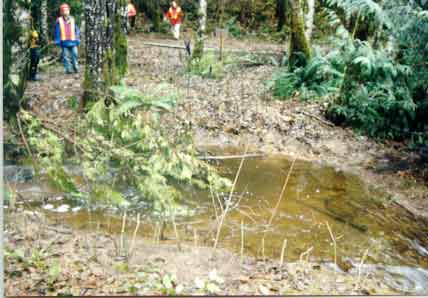
Combining vegetative and rock methods to balance habitat issues with budgetary constraints and site conditions.
Techniques
Joint plantings can be use to improve bank protection by forming a vegetative root mat and increasing deposition of sediment and debris. Live cuttings are staked within a riprap matrix either during or after riprap placement.
Vegetated geogrids are useful to provide immediate erosion control, where steep banks cannot be sloped back. This technique is similar to brush layering except that the fill soil is wrapped in geotextile material such as jute, reed, flax, or cellulose.

Tree revetments can be applied to protect banks from scour and toe erosion in sites of low or moderate energy. In lower energy sites, whole coniferous trees are anchored with cable to stream banks with the butt end or rootwad pointing upstream. In moderate energy sites, integrated tree-rock-live cutting structures can be built in an interlocking matrix. Working upstream, excavate footer log as deeply as possible. Place rootwad so that the fan is overhanging the footer log and then install header logs and rocks. Backfill with soil and plant with live cuttings. Tree revetments should be combined with deflectors or tie-backs and a rock toe key should be used if the water depth exceeds 1m, or if the gradient exceeds 2%. To increase the lifespan of tree revetments, install dense coniferous species such as western red cedar, Douglas fir, or western hemlock.
Large woody debris may be utilized as a component of integrated bank protection, to enhance habitat and create diversity. Large woody debris must be properly anchored and is most effective when used in a series of several woody pieces, and in combination with rock toes and vegetative methods in the bank zone.
Advantages of Integrated methods:
-some may be constructed on near vertical banks providing undercuts for fish habitat
-enhanced flexibility utilizing a variey of organic and synthetic materials
-fits into the surrounding infrastructure; useful in areas where bank regarding is limited due to the close proximity of built structures
Disadvantages of Integrated methods:
-design criteria can become labour intensive
-project success is often based on the quality of the construction
-the use of heavy equipment may be necessary for excavation
-requires monitoring
-can be expensive
© 2009 Veins of Life Watershed Society / All Rights Reserved / if you wish to use any info for commercial or non commercial usage you must obtain permissions from The Veins of Life Watershed Society